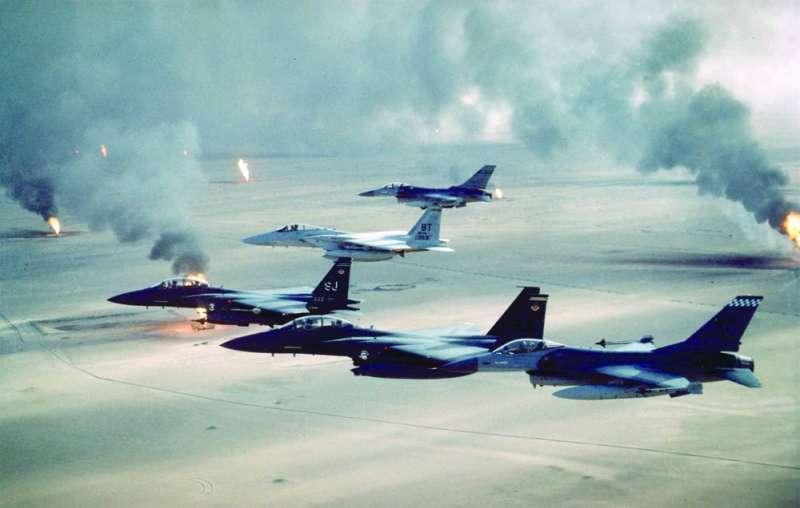Elaph from Beirut: Operation Desert Storm included the combat debut of stealth technology, global positioning system navigation, missile warning systems, the most advanced surveillance aircraft radar, and large quantities of precision-guided bombs.
When GPS-enabled sensors pinpointed enemy targets, spotter planes monitored enemy troop movements, while stealth bombers eluded radar tracking from air defenses in the early days of Operation Desert Storm decades earlier - in January 1991 - very few of participants most likely think about how to do it. These attacks signal a new era in modern warfare.
Many analysts and strategists at the Pentagon are quick to point out that the margin of US military-technological superiority is much smaller than it was at the time of the Gulf War. Since then, potential adversaries have gone to school about American weapons and narrowed the gap.
What the world has learned
Operation Desert Storm included the combat debut of stealth technology, a global positioning system for navigation, missile warning systems, the most advanced surveillance aircraft radar, and large quantities of high-precision laser-guided bombs, (currently retired) Major General Paul Johnson, (Formerly ) Director of Requirements to the Deputy Chief of Staff for Strategic Plans and Requirements, Warrior told in an exclusive interview several years ago.
Johnson retired from the Air Force in 2016, after ending his long and distinguished career in the Air Force – which included flying high-risk A-10 combat missions during the Gulf War. Johnson spoke with Warrior before he retired to provide a rare and experienced perspective on the emergence of new technologies during the Gulf War. "We saw the first glimpses in Desert Storm of what would become the transformation of the Air Force," he said years ago.
The five- to six-week air war, designed to pave the way for what eventually became a 100-hour ground invasion, began with cruise missiles and helicopters of the Air Force and Army on a high-risk mission behind enemy lines to strike Iraqi forces. Early warning radar sites. Johnson explained that two MH-53 Low Pave helicopters drove the AH-64 Apache Attack Helicopter into Iraqi territory. The mission was to completely destroy the early warning radar in order to open an air corridor for aircraft to fly safely and attack Iraqi targets. The mission was successful.
"This was the dawn of GPS - the ability to accurately navigate anywhere, anytime without any other navigation systems. The Pave Lows had this technology and the Apaches didn't. Now, everyone has it on their iPhone but in Today and the time it was truly revolutionary."

Johnson explained that the priority targets during the air war consisted of Iraqi artillery designed to hit any potential Iraqi ability to launch chemical weapons. Other priority targets, of course, included Iraqi air defenses, troop formations, armored vehicles, and command and control sites. The air attack included F-117 Night Hawk stealth bombers, B-52s, F-15 Eagles, and a low-flying A-10 Warthog.
At some point during the air war, Johnson's A-10 Warthog was hit by an Iraqi shoulder missile while attempting to attack enemy surface-to-air missile sites over Iraqi territory. He says, "I found myself under the weather trying to carry out an attack that failed. I was hit in the right wing. I screamed and finally turned off the microphone and decided to tell everyone I had been hit. I got the plane back safely. They repaired the plane in about 30 days. Enemy fire hit the right wing of the plane and the wing was It's a bit of a mess, but I had enough control to keep the wings level."
The first appearance of new technology
While there weren't many air battles during Desert Storm, the Iraqis did attempt a few MiG-29 fighter jets. The emergence of many precision air-launched precision weapons, aided by overhead observation and GPS navigation, is noted. GPS-guided bombs, called Joint Direct Attack Munitions, did not yet exist at the time of the first Gulf War—but GPS navigation technology greatly improved the ability of pilots and ground forces to know exactly where they were in relation to surrounding areas, land movements, and enemy force. .
This was particularly valuable in Iraq because of the terrain, Johnson explained. There were no terrain or mountainous regions as landmarks from which to navigate. The landscape was entirely desert with no roads, terrain, or rivers.
In addition, the extensive use of laser-guided weapons has allowed air assets to pinpoint Iraqi targets from the laser spot - thus increasing accuracy and mission efficiency while minimizing collateral damage. He explained that laser weapons have been around since Vietnam, "but we have used laser-guided bombs in numbers that we have not done before."
Some of the weapons dropped included Maverick missiles, the 2,000-pound Mk 84, the 500-pound Mk 82 and cluster weapons. The Maverick missile is a precision anti-tank weapon that uses electro-optical precision weapons to destroy targets.
"In Desert Storm," he says, "you had the ability to dynamically see what was going on on the battlefield and perform command and control in real time. You had the ability to navigate with incredible precision and then the ability to use precision weapons - one weapon kills one target." every time ". According to him, Desert Storm also included the combat debut of cross-line-of-sight satellite communications that provide, among other things, missile warning systems. "We didn't shoot every Scud, we knew where it would land," Johnson recalled.
Johnson explained that the Gulf War changed the paradigm for the strategic use of air power by allowing a single aircraft to strike multiple targets with precision rather than using unguided bombs to cover an area: "We started a change in calculus. The calculus was always... how many Aircraft needed to destroy a target?A-10s can lay a series of bombs across the target area and hope one of the bombs hits the target.By the end of the 1990s, the calculus was: How many targets can one aircraft destroy?".
This report was prepared by Elaph for the National Interest.
